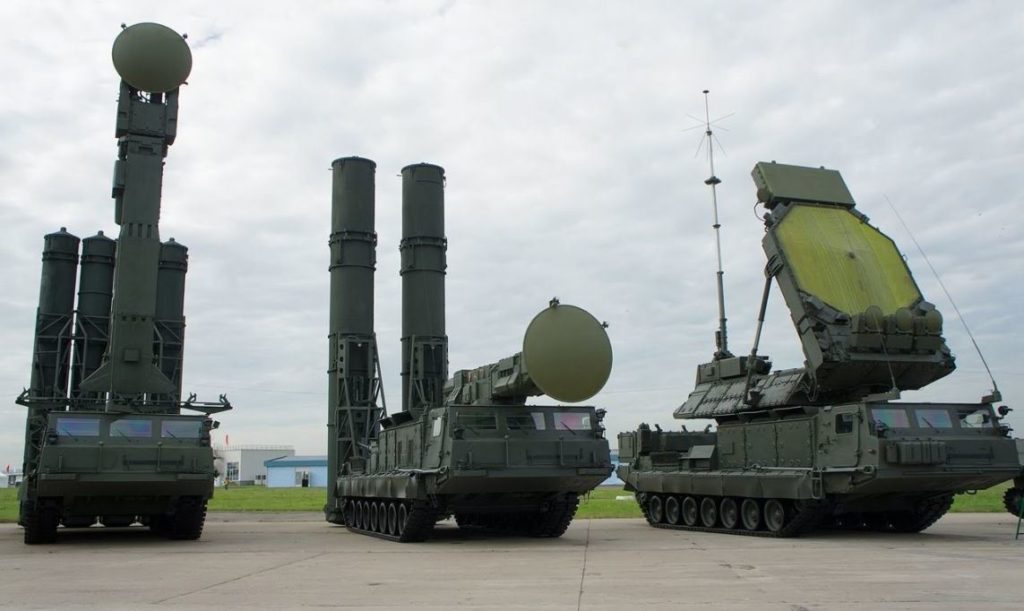A Kennedy perspective — Syria: Another Pipeline War by Robert F. Kennedy, Jr. — and now a flashpoint in the making. S-300s roll in, the most advanced Russian missile defense system. Ask what could and most likely would happen if a no-fly zone proposal collapses and a US fighter is shot down
- Update / October 25 / Via the Guardian
- Many in national security circles consider the risk of a confrontation with Russia to be severe: ‘I wouldn’t put it past them to shoot down a US aircraft’
- Retired senior US military pilots are increasingly alarmed that Hillary Clinton’s proposal for “no-fly zones” in Syria could lead to a military confrontation with Russia that could escalate to levels that were previously unthinkable in the post-cold war world. The former strategists spoke to the Guardian as Clinton’s Republican rival Donald Trump warned that Clinton’s proposal to establish “safe zones” to protect beleaguered Syrian civilians would “lead to world war three”. The proposal of no-fly zones has been fiercely debated in Washington for the past five years, but has never attracted significant enthusiasm from the military because of the risk to pilots from Syrian air defenses and the presence of Russian warplanes. Many in US national security circles consider the risk of an aerial confrontation with the Russians to be severe.
Ratcheting Up, New Missile Defenses Deployed In Syria
Background of Failed Policy and Widening Conflict
From the perspective of StratDem, the conflict in Syria goes far beyond oil and gas pipelines. We agree with Robert Kennedy though in drilling down for a deeper look at causes for war, as the classic casus belli is not readily visible in Syria.
Ask ‘experts’ for the causes of the Syrian disaster and the answers will range from outside forces to internal civil war; from drought and flight to the cities to the import of weapons from a ‘liberated’ Libya; from collapse of the Arab Spring to Israeli intrigue; from US disaster in the Iraq war and cross-border consequences of the devastation delivered to millions — and millions of migrants and those preaching ‘eye for an eye’ revenge; from Saudi-exported Salafi/Wahhabism and Jihadi extremism to calculated western geopolitics; from Russian hard power that recalls the crushing war in Chechnya-Grozny across to many pronged enmities of Iranian, Turkish and Lebanese Hezbollah forces arrayed against regional foes.
What we do know is, as the sources and causes are hydra-like, the solutions and remedies will not come without consequences and costs.
The question for now is how to prevent wider conflageration or a mistake, a provocation, a flashpoint that leads to escalation of conflict between the US and Russia — an escalation that could quickly dissolve into entangling alliances and larger forces being drawn in with much greater consequence.
First, let’s look back at the oil/gas pipeline battle between ‘East and West’, even as Russia-Turkey announce a new deal for the Black Sea pipeline that will be a game changer in the geo-politics of energy and Europe.
Here is Robert Kennedy’s perspective on pipeline war — Syria: Another Pipeline War
It is not an easy read, but it is a necessary read…
Growing Crisis in Syria
This past week, negotiations between the US and Russia collapsed, and nuclear weapons agreements were ended peremptorily, and the UN Security Council resolutions on Syria failed, the conflict in Syria took another ominous turn.
The most advanced missile-system of Russia was moved into Syria.
Here is the S-300 latest iteration.
Via DefenseWorld
__________________________________
Via The American Conservative
Both the U.S. and Russia are prepared to go there under certain circumstances
People who make their living thinking about defense policy and national security like everything to fit into a nice framework…
Nuclear war was such an awful prospect that it long was described as intrinsically the ultimate universal deterrent, rendering an actual armed conflict between NATO and the Warsaw Pact that might escalate unthinkable.
The end of the Cold War in 1991 seemed to reduce the chance of nuclear war still further, even though the weapons had proliferated. But no one anticipated the level of hostility toward Russia that is now evident, and talk in the Pentagon is again focused on what it would take to win a war against an apparently resurgent Moscow. And for his part, earlier this week, Russian President Vladimir Putin withdrew from a nuclear security pact, citing “hostile actions” by the U.S.
~
Last month there were reports that President Obama had considered committing to “no first use” but was overruled by his cabinet, with Secretary of Defense Ash Carter describing such a pledge as “a sign of weakness.” Two liberal congressmen have since introduced a bill that would prohibit U.S. first use of nuclear weapons, but it appears to have little support and is likely to die in committee…
Carter is admittedly an anti-Russian hawk. He is also a physicist by training and is somewhat of an expert on policies relating to the use of nuclear weapons. Some of the changes he has made to our nuclear-deterrent policies were recently observable on CBS’s 60 Minutes, which ran a series on the state of the American nuclear arsenal.
~
(W)hat has changed the calculus is the sophistication of the weapons themselves.
New tactical nuclear weapons, like the latest versions of the U.S. B-61, are small and portable. They can be launched from a bomber or as part of a cruise missile or even from a ground installation or vehicle. Further, their operators can “dial up a yield”—i.e., select the size of the explosion on the bomb itself.

This selectivity makes such a bomb, in the minds of some generals and politicians, potentially an effective warning rather than an automatic escalation of the fighting—and as a result it is a weapon that is much “more usable.”
(T)here are frightening indications that some senior military officers might be eager to get things started in the belief that a war with Russia could actually be winnable. Certifiable loose cannons on deck include Wesley Clark, who reportedly tried to engineer a confrontation with Russian peacekeepers in Kosovo in 1999. Crazier still, Gen. Philip Breedlove (who retired earlier this year) worked hard during his time as supreme commander of NATO forces in Europe to get NATO and the U.S. involved in a proxy war over Ukraine.
The general was also reportedly in contact with State Department Assistant Secretary of State for European and Eurasian Affairs Victoria Nuland, who helped engineer the coup that overthrew the Ukrainian government in 2014.
Meanwhile, Hillary Clinton is calling Putin a new Hitler while the New York Times editorializes against “Vladimir Putin’s Outlaw State.”
~
Opinion polls suggest that the average Russian now expects war with the West.
The insistence on the part of the many in the West that Putin must be resisted by using force majeure if necessary is based on gross exaggeration of the actual threat coming from Moscow. That nuclear weapons are now apparently employable in the plans for deterrence on the part of NATO, as well as in the Russian plans for self-defense, should be a terrifying prospect for anyone who cares about what might come next.
More:
The S-300 system will improve Russia’s ability to control air space in Syria, where Moscow’s forces support the government of President Bashar al-Assad, and could be aimed at deterring tougher U.S. action…
“The S-300 basically gives Russia the ability to declare a no-fly zone over Syria.”
…. S-300VM antiaircraft missile system can (theoretically) take out U.S. warplanes should any come within range. The Kremlin’s chief media mouthpiece, the U.S.-sanctioned Dmitry Kiselyov, who hosts the tabloid propaganda show News of the Week, was straightforward: “We’ll shoot them down.”
Russian Defense Ministry spokesman Maj. Gen. Igor Konashenkov has all but threatened to do just that, amid recent disclosures that the Obama administration may be mulling a military confrontation with the Assad regime, as recommended by the Joint Chiefs of Staff and CIA, both of which fear that the fall of Aleppo would exacerbate U.S. terrorism threats.
In response to White House spokesman Joshua Earnest’s questioning Russia’s need for advance anti-aircraft deterrent when Russia’s year-long intervention in Syria was meant to target ISIS, whose aerial component has yet to announce itself, the Twitter account of the Russian embassy in the U.S. posted a mocking image responding, “Because you never really know what kind of assistance terrorists might get.”
The rapid unraveling of the US-Russia relationship over their failed effort to establish a cessation of hostilities between Syria’s government forces and moderate opposition groups may become increasingly dangerous for Syrians and the Middle East as a whole. Indeed, respected Russian defense and foreign policy expert Dmitri Trenin, a former Russian military officer who directs the Carnegie Moscow Center, has argued that Syria could become a “battlefield between the two” and that this is an “exceptionally disturbing prospect that should keep people in Moscow and Washington awake at night.” Trenin is right to be concerned.
The day after the United States issued a press statement announcing its suspension of talks with Russia on implementing the cessation of hostilities, The Washington Post reported on a National Security Council meeting to discuss possible strikes on Syria’s military, including options such as cruise missile attacks on runways, presumably intended to slow or stop Syrian airstrikes (particularly around Aleppo). The next day, Russia’s Defense Ministry spokesman appeared to respond directly to this article. In a press briefing, he warned the United States that Russia had deployed S-300 and S-400 missile systems at its facilities in Syria, that US strikes would threaten Russian military personnel “on the ground” in the country and that Russian air defense crews would “hardly” have time to assess incoming attacks to determine their flight paths. This amounts to a statement that Moscow might respond directly to any US attacks on Syrian forces.
In an interview with Al-Monitor, Trenin confirmed this and noted that the spokesman’s reference to “unidentified flying objects” was especially significant. “I take this as a warning that not only US cruise missiles but also its aircraft might become Russian targets,” he said, adding that “Moscow seeks to deter the US from attacking Syrian government forces and assets.”
… the breakdown in the cessation of hostilities has metastasized.
Taken together, Moscow’s conduct and statements suggest that the Kremlin may have reached — and quite possibly passed — a tipping point in its assessment of Russia’s relations with the United States.
⇒
Read More at StratDem on the New Cold War becoming hotter




